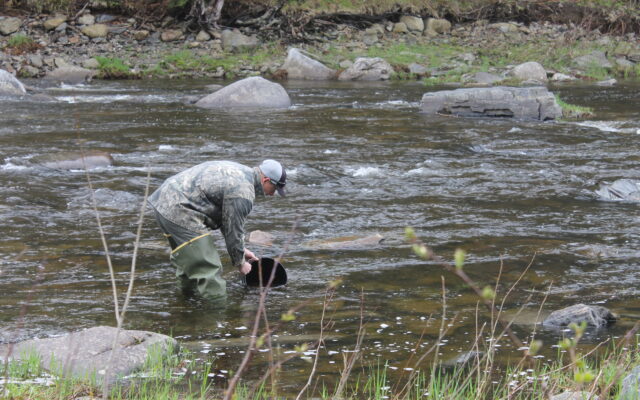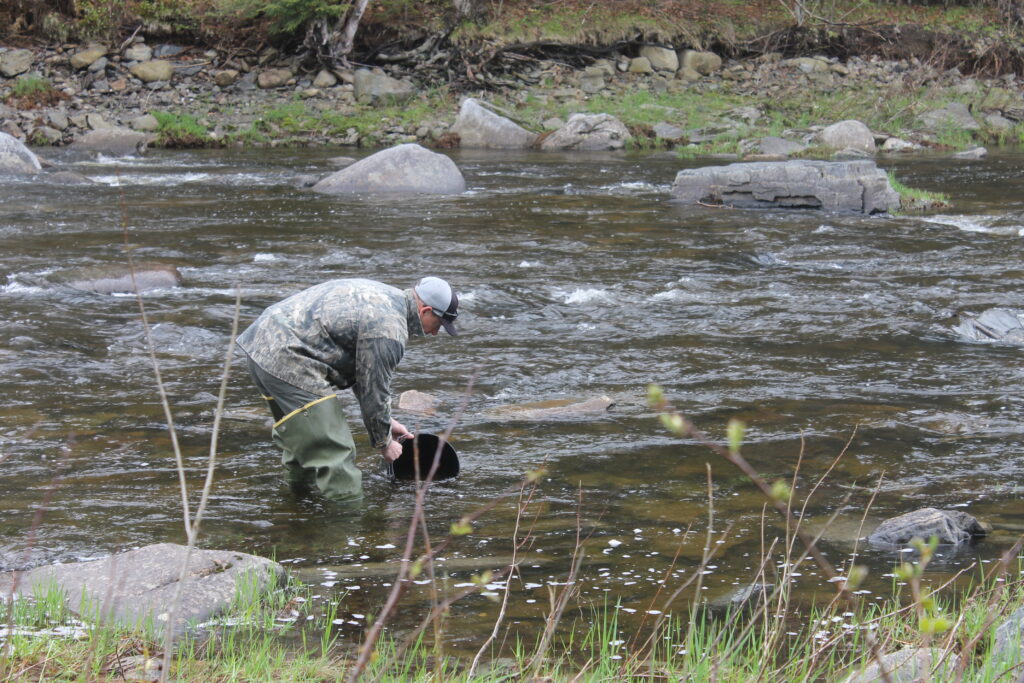
Kingsbury Stream stocked with Atlantic salmon
ABBOT — For a decade and a half Atlantic salmon have been an endangered species in many Maine waterways. To help bring the numbers back up, state and federal agencies have been reintroducing young salmon in various rivers and streams. This includes Kingsbury Stream in Abbot, which flows into the Piscataquis River.
On Thursday, May 9 about 10,000 freshly-hatched juveniles or frys were placed in the stream off Coles Corner Road with about 80,000 total frys being taken from four large coolers into the Kingsbury Stream via the bucketful at half a dozen locations that day. The stocking spots are each easily accessible by foot.
Maine Department of Marine Resources Marine Scientist Peter Ruksznis of Guilford, who has been with the agency for 30 years, told a small group traveling to the site to witness the Atlantic salmon stocking that young fish are classified as either frys or smolts — which are older and larger in size.
“These will live in this river and become accumulated to Kingsbury Stream and the Piscataquis River and where else we put them for the next two to three years,” Ruksznis said. “This is where these guys are going to want to come back to.”

SALMON STOCKING — Graham Goulette, fisheries biologist with the National Oceanic and Atmospheric Administration, places some freshly-hatched Atlantic salmon, called frys, in Kingsbury Stream in Abbot on May 9. State and federal agencies have been working to bring species numbers back up in Maine waterways.
He said smolts are stocked below the Milford Dam on the Penobscot River to help with the survivability rate of the species. Ruksznis said below Milford dam about one out of every 100 Atlantic salmon will make it back, but up in Kingsbury Stream this ratio is only about one per every 1,000 fish.
He mentioned one stream was stocked for five years but not a single adult came back. “The ocean eats them,” Ruksznis said, comparing the Atlantic to a black hole for the fish.
When asked, he said the number would be just about zero without the efforts of the Maine Department of Marine Resources, the National Oceanic and Atmospheric Administration, and others.
“They have been on the endangered species list since 2009 in the Penobscot,” Ruksznis said. “In 2000 they listed coastal rivers, from Bangor south were listed, and I think in 2009 they listed the rest of the Penobscot, the Kennebec, all the hatchery fish became endangered at that time. A piece of the Saco and then a piece of other things.”
He mentioned NOAH designated almost all Maine watersheds that originally had Atlantic salmon as critical habitat.
“Every river has a distinct population,”said NOAH Fisheries Biologist Graham Goulette. He said DNA from a scale sample can be used to determine the river type and if the Atlantic salmon is wild or reared by an agency.
Ruksznis said portions of the Piscataquis and Pleasant rivers and many of the tributaries are the “best of the best habitat” for frys. He mentioned the cold water and little to no pollution as key factors.
Smallmouth bass pose a bigger threat to Atlantic salmon than pike, Ruksznis said. “They compete more at this age and they live right there alongside them behind that rock in the exact same spot and a pike does not live in that type of habitat,” he said.
“Smolts will take a hit as they migrate from here to the ocean wherever pike might happen to be,” Ruksznis added.
The marine scientist was asked about the impact of removing the Mayo Mill Dam in downtown Dover-Foxcroft on Atlantic salmon.
“It’s only going to have an impact on fish passing through there, without the dam you’re going to have less temperature, less predators holding in a pond because it will turn more into a river,” Ruksznis said, noting that having the body of water be more of a river is not as favorable for non-natives species.